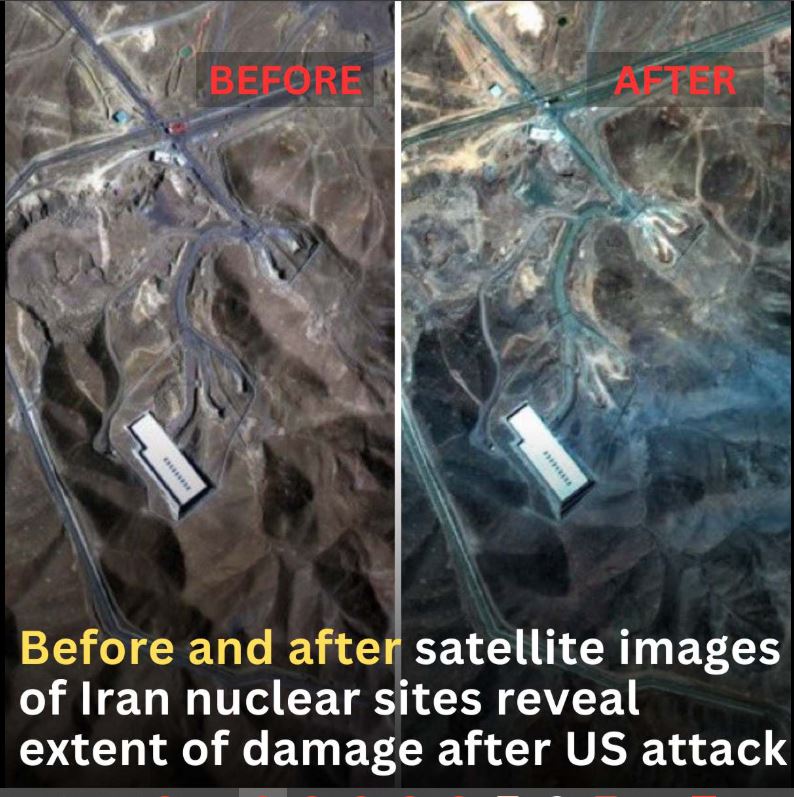

WASHINGTON, DC: Exclusive satellite images released on Sunday, June 22, reveal the devastating aftermath of US airstrikes on three of Iran’s most critical nuclear sites.
Captured by Maxar Technologies, the images show widespread damage at the Fordow, Natanz, and Isfahan facilities after a surprise assault by American B-2 stealth bombers.
The strike marked a dramatic escalation in the region, as President Donald Trump formally aligned the United States with Israel’s ongoing military campaign to dismantle Iran’s nuclear program.
Using powerful bunker-busting munitions designed to penetrate hardened underground targets, the US targeted Iran’s enrichment infrastructure in what may be a turning point in the long-simmering standoff.
Damage inflicted on Fordow nuclear facility
Satellite imagery analysis reveals a vast layer of gray-blue ash blanketing the area around Iran’s Fordow nuclear facility, clear evidence of the immense force unleashed by US bunker-busting bombs during the recent strike, as per NewsNation.
The images show massive craters carved into the ridge above the subterranean complex, with multiple tunnel entrances leading into the facility now buried under collapsed earth and debris.
Fordow, located deep within a mountain near the city of Qom, which is believed to be a revered site in Shi’a Islam, has long been a focus of Western intelligence due to its hardened, blast-resistant design intended to survive direct military attacks.
The latest image from Maxar Technologies captures several impact points, likely from bomb strikes, with distinct ash-like markings surrounding the blast sites, further underscoring the scale and precision of the assault.
Natanz nuclear facility

Before-and-after satellite images of Iran’s Natanz nuclear facility reveal a precisely placed crater measuring approximately 5.5 meters in diameter, directly above a section of the underground military complex.
Natanz is a key site in Iran’s uranium enrichment program, housing advanced centrifuges critical to the production of nuclear material.
The crater’s exact alignment over the subterranean centrifuge area suggests that the bunker-busting munitions successfully pierced the facility’s protective layers of earth.
Archival imagery from Maxar Technologies, dating back to 2003, shows the site during its construction phase—when the centrifuge halls were still visible above ground.
These structures were later buried under reinforced earth to shield them from potential aerial attacks. The new images strongly indicate that this once-secure protective covering has now been breached.
Isfahan nuclear technology complex

Satellite imagery analysis indicates widespread structural damage across the entire Isfahan nuclear technology complex, following the recent US airstrikes. The facility, a cornerstone of Iran’s nuclear research efforts, appears to have suffered extensive destruction, with multiple buildings showing signs of significant impact.
As Iran’s principal hub for nuclear technology development, the scale of the damage at Isfahan marks a major setback to the country’s scientific and strategic capabilities.
Air Force General Dan Caine declares all three Iranian nuclear sites have suffered damage
During a Sunday morning press briefing at the Pentagon, Chairman of the Joint Chiefs of Staff, Air Force General Dan Caine, confirmed that all three targeted Iranian nuclear sites suffered what he described as “extremely severe damage and destruction.”
He noted, however, that it would take time to fully evaluate the extent of the structural and operational losses at each facility, as per Fox News.

General Caine went on to describe the scope of Operation Midnight Hammer, calling it “the largest B-2 operational strike in US history.” The mission involved over 125 aircraft and was executed using sophisticated deception tactics to maintain surprise.



